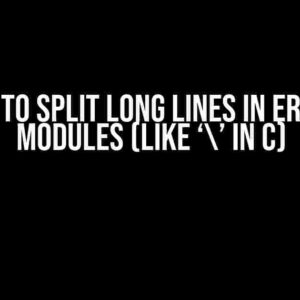Hey there, fellow coders! Today, we’re going to tackle a crucial aspect of programming: type hinting. Specifically, we’ll explore how to type hint an attribute that can be assigned with a value of a super type. But before we dive in, let’s set the stage with a quick refresher on type hinting and its importance in programming.
What is Type Hinting?
Type hinting is a feature in programming languages that allows developers to specify the data type of a variable, function, or attribute. This information helps the language’s built-in type checker ensure that the assigned value is compatible with the specified type. Type hinting is essential in statically-typed languages like Java, C#, and Go, as it helps catch type-related errors at compile-time rather than runtime.
Why is Type Hinting Important?
Type hinting offers several benefits, including:
- Improved code readability: By explicitly stating the expected data type, you make your code more readable and easier to understand.
- Error prevention: Type hinting helps catch type-related errors early on, reducing the likelihood of runtime errors and making your code more reliable.
- Better code completion: Many Integrated Development Environments (IDEs) use type hinting to provide more accurate code completion suggestions.
- Enhanced code maintenance: Type hinting makes it easier to modify and maintain your codebase over time.
What is a Super Type?
In object-oriented programming, a super type (also known as a parent or base class) is a class from which another class inherits properties and behavior. The super type provides a set of common attributes and methods that can be shared by its subclasses.
The Problem: Type Hinting an Attribute with a Super Type
Now, let’s get to the main event! When you have an attribute that can be assigned a value of a super type, things can get tricky. You want to ensure that the attribute can accept values from the super type as well as its subclasses. But how do you type hint this attribute correctly?
Example Scenario
Imagine you’re building a simple shape library in Python. You have a base class called `Shape` with subclasses like `Circle`, `Rectangle`, and `Triangle`. You want to create an attribute called `shapes` that can hold a list of any shape type, including the super type `Shape` and its subclasses.
from typing import List
class Shape:
pass
class Circle(Shape):
pass
class Rectangle(Shape):
pass
class Triangle(Shape):
pass
class ShapeContainer:
def __init__(self):
self.shapes: List[????] = [] # What type hint do we use here?The Solution: Using the `Union` Type
In Python, you can use the `Union` type to specify that an attribute can accept values from multiple types, including the super type and its subclasses. Here’s how you can type hint the `shapes` attribute:
from typing import List, Union
class ShapeContainer:
def __init__(self):
self.shapes: List[Union[Shape, Circle, Rectangle, Triangle]] = []By using the `Union` type, you’re telling the type checker that the `shapes` attribute can hold a list of values that are either instances of `Shape` or any of its subclasses (`Circle`, `Rectangle`, or `Triangle`).
Benefits of Using `Union`
Using the `Union` type offers several benefits, including:
- Improved code flexibility: By allowing the attribute to accept values from multiple types, you make your code more versatile and easier to work with.
- Enhanced type safety: The `Union` type ensures that the attribute can only hold values that are compatible with the specified types, reducing the risk of type-related errors.
- Better code readability: The `Union` type makes it clear that the attribute can accept values from multiple types, making your code easier to understand and maintain.
Alternative Solutions
While the `Union` type is a great solution, there are alternative approaches you can use depending on your specific use case:
Using the `Any` Type
In some cases, you might want to use the `Any` type to indicate that the attribute can hold values of any type. However, be cautious when using `Any`, as it can bypass type checking and lead to runtime errors.
self.shapes: List[Any] = [] # Use with caution!Creating a Common Interface
Another approach is to create a common interface or protocol that all shape classes implement. This allows you to type hint the attribute with the interface type, ensuring that only compatible values can be assigned.
class ShapeInterface(Protocol):
def area(self) -> float:
...
class ShapeContainer:
def __init__(self):
self.shapes: List[ShapeInterface] = []Conclusion
In conclusion, type hinting an attribute that can be assigned with a value of a super type requires careful consideration. By using the `Union` type, you can ensure that your attribute can accept values from the super type and its subclasses, while maintaining type safety and code readability. Remember to consider alternative solutions depending on your specific use case, and always prioritize code maintainability and reliability.
Final Tips and Tricks
Before we wrap up, here are some additional tips and tricks to keep in mind:
- Use type hinting consistently throughout your codebase to ensure consistency and improve code readability.
- Take advantage of your IDE’s code completion features to get accurate suggestions based on type hinting.
- Use type hinting to document your code and make it easier for others to understand.
- Remember that type hinting is not a replacement for proper error handling and validation.
With these tips and the knowledge you’ve gained from this article, you’re ready to tackle even the most complex type hinting challenges. Happy coding!
| Type Hinting Tip | Description |
|---|---|
| Consistency is key | Use type hinting consistently throughout your codebase. |
| IDE integration | Take advantage of your IDE’s code completion features. |
| Documentation | Use type hinting to document your code and make it easier to understand. |
| Error handling | Remember that type hinting is not a replacement for proper error handling and validation. |
Thanks for reading, and don’t forget to share your own type hinting tips and tricks in the comments!
Frequently Asked Question
Hey there, coding wizards! Are you stuck on how to type hint an attribute that can be assigned with a value of super type? Worry not, we’ve got you covered! Here are some frequently asked questions to guide you through this magical realm:
Q1: Why do I need to type hint an attribute with a super type?
You need to type hint an attribute with a super type because it allows for greater flexibility in your code. By doing so, you can assign a value of the super type or any of its subtypes to the attribute, making your code more dynamic and reusable.
Q2: How do I type hint an attribute with a super type in Python?
In Python, you can type hint an attribute with a super type using the ` typing.Type` module. For example, if you have a class `Animal` and you want to type hint an attribute `pet` that can be assigned with a value of `Animal` or any of its subtypes, you can do it like this: `pet: typing.Type[Animal]`.
Q3: Can I use type hinting with Union types to specify multiple super types?
Yes, you can use type hinting with Union types to specify multiple super types. For example, if you want to type hint an attribute `pet` that can be assigned with a value of either `Animal` or `Plant`, you can do it like this: `pet: typing.Union[Animal, Plant]`.
Q4: How do I handle the case where the attribute can be None or have a value of the super type?
To handle the case where the attribute can be None or have a value of the super type, you can use the `Optional` type from the `typing` module. For example, if you want to type hint an attribute `pet` that can be assigned with a value of `Animal` or any of its subtypes, or None, you can do it like this: `pet: typing.Optional[typing.Type[Animal]]`.
Q5: Are there any best practices I should follow when type hinting attributes with super types?
Yes, there are best practices to follow when type hinting attributes with super types. For instance, make sure to use meaningful and descriptive type hints, and avoid using type hints that are too vague or broad. Additionally, consider using type hints consistently throughout your codebase to make it easier for others (and yourself!) to understand and maintain.


